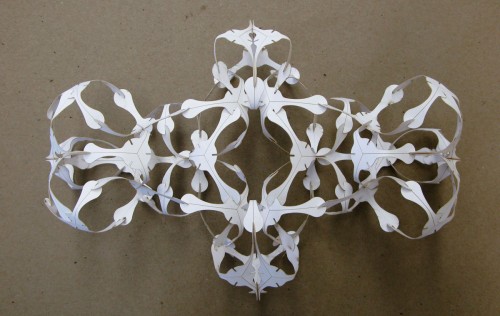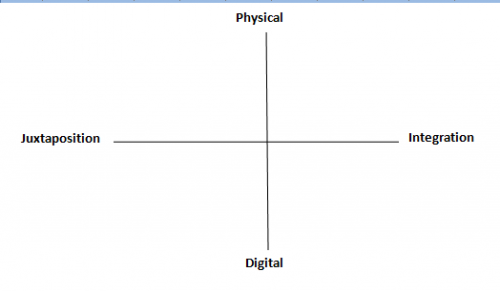A distinct feature of academically oriented blogs like Cyborgology is that these are spaces in which theories take shape over time through conversation, contradiction, progression, and stumbles. Rather than a finished product, readers find here a theoretical process, one that is far from linear and often fraught. It is in this messy and fractured way that theories of digital dualism and augmented reality continue to develop here at Cyborgology and connected sites. In this spirit of processual-theorizing, I want to further refine my material mapping of digital dualism for yet a third time*. With the ongoing dualism debates, the time is ripe for theoretical rethinking and adjustments.
Before going further, I want to clarify what I mean by “material conditions.” I do not refer here to an inherent or essential component of an artifact, space, or place, or to atoms as opposed to bits. Rather, because technology is always intertwined with human users and creators, the material conditions of which I speak stem from human-infused architectures of both brick and code, usage patterns, public discourses, and personal narratives.
Nathan Jurgenson first typologized digital dualism and augmented reality into increments between Ideal Type poles of strong and mild. He lamented the messy theorizing that slipped, in sometimes indiscriminate ways, along this continuum even within a single argument. In curbing his critique, I argued that such slippery theorizing is largely a product of variation in material conditions, and in particular, variations in the physicality and digitality of particular artifacts, spaces and places (for purposes of clarity: original Jurgenson post, original material mapping post, adjustment to material mapping post, application of material mapping post).
In mapping the material conditions of digitality and physicality, I set up integration and dualism as Ideal Type poles between which objects of study vary. At one pole rested the purely digital or purely physical, at the other the purely enmeshed physical and digital. Each of these poles are empirically unreachable but act as extreme cases against which all else can be compared (i.e. they are Ideal Types). The gist here is that although digital and physical are always intertwined, they do not always hold the same degree of presence. Rather, some things are more integrated, others more separate. This formulation, however, ignores the ways in which seemingly “pure” technologies are, in fact, not so pure. It concedes to discourses of separation in a way that enables the obscuring of digital-physical relations.
In particular, I think the pole of material dualism or separation can more accurately be replaced with juxtaposition. I argue that a formulation of the material conditions of physicality and digitality should be relational rather than oppositional. That is, if we understand the physical and digital to be always co-present, the question is how physical and digital relate to one another within an artifact, space, place etc. I therefore argue that we can understand these relations in terms of integration and juxtaposition.
By integration, I refer to a strong and at times explicit enmeshment of digital with physical. Facebook here is a useful example. Facebook is a digital platform on and through which bodied and named persons perform and negotiate identity, community, and relationships. Facebook’s Terms of Service require users to identify with their “real names”; mobile applications enable Facebook interaction within an array of physical spaces, often in conjunction with Face-to-Face interaction; the architecture of the site promotes biographical sharing through both text and images; and the normative structure surrounding Facebook use maintains a strong ethic of honesty and authenticity. MySpace, on the other hand, though sitting close to the integration pole, is less integrative than Facebook due to the formally and informally accepted use of aliases instead of given names. That is, MySpace, while highly integrative, is more juxtapositional than Facebook.
By juxtaposition I refer to a supposed defining-against, through which digital or physical appear purely such due to their oppositional relation with the other. For example, “the wilderness,” a space without wifi or possibly even cell phone connection, is set up not only as physical, but as explicitly not digital. It is, in short, offline, a location that makes sense only in relation to what it is not (i.e. online). Similarly, MMORPGs, in which players inhabit alien digitized bodies, take on new names and labels disconnected from Face-to-Face identity signifiers, and engage in fantasy play, are defined against, or in juxtaposition to, the physical.
The major poles then in this new schema are juxtaposition and integration, and refer to the relationship between digital and physical, recognizing that both are always co-present. The simple model looks like this:
I am hesitant here to name categories between these poles, as I think a more open formulation lets us move more fluidly, theoretically speaking, between juxtaposition and integration in thinking about material conditions. I do, however, think that this continuum will be improved through multidimensionality. In particular, as an object moves between juxtaposition and integration, there may also be movement between an emphasis on digital or physical. For instance, the wilderness is physicality defined against digitality, while MMORPGs are digitality defined against physicality. MySpace is largely integrationist, but arguably slightly more digital than physical. The multidimensional formulation can be depicted as follows:
The key here is to remember that physical and digital are both always around, be it through explicit co-presence or conspicuous absence.
Jenny Davis is a weekly contributor to Cyborgology and continues to fumble through this collective theoretical project. Follow her fumblings on Twitter @Jup83
*This third round of theorizing is largely i indebted to insightful comments let by Nathan Jurgenson on my second attempt to map the material conditions of digital dualism
Pic Creds:





Comments 15
quiet riot girl — March 26, 2013
'A distinct feature of academically oriented blogs like Cyborgology is that these are spaces in which theories take shape over time through conversation, contradiction, progression, and stumbles.'
-and research I hope. I am a researcher currently and I find that 'theory' only gets so far through the methods you describe. Interviews, surveys, participant observation, focus groups may not sound sexy but they help us develop 'theory'.
Digitism – Part 2 (Mapping) | Atomic Geography — March 26, 2013
[...] at Cybogology, Jennie Davis has put up a post Multidimensional Material Mapping. She argues and I quite [...]
nathanjurgenson — March 26, 2013
jenny, really dig this post! i'm hopping that digital dualism theory does not only serve as a critique, but also a positive theory that does new work. this direction we've been working at demonstrates how the digital dualism critique is the best way of explaining *difference*. where i'd like to go with this, and very much the opposite of what Nick Carr says, is that a non-dualist, synthetic perspective that always takes into account the enmeshing of the on/offline is *necessary* to explain the variety of very different ways that people encounter the digital.
can i take a stab at filling in your four-fold table - am i on the right track?
Louise — March 27, 2013
This is great. Brilliant model. What it brings up for me is the way digital dualism and augmentation are both cultural stories about the digital/physical relationship...some of the arguments here seem to surround descriptive or truth value. Ie: what is more true - DD or AR?
But both seem to be different ways of narrating that relationship. If you play Call of Duty it may be a dualistic experience, and if you go on Facebook a juxtapositional or augmented one. So does it not make more sense to talk about DD and AR as co-existing cultural narratives, each with particular ideological and emotional investments behind it?
Louise — March 27, 2013
QRG - for me the payout of using a model of this kind is being able to see relationships and variations - but it's also the process dimension of actually using it, and working out where examples could sit (and 'could' rather than 'should' is important).
Testing the model with hard-to-locate examples is a brilliant idea as that require most thought - and a tool like this has great value as an open-ended stimulus to thinking. The very fact that there are no easy answers is revealing in itself - but it would be harder to see that without a structure like this to start with. I certainly don't see it as trying to fix fluid experiences. Maybe it could be seen as a thought experiment?
The Place of Blogs in Academic Writing » Cyborgology — April 23, 2013
[...] know about, or don’t know enough to trust. And I know I’ve written bad ideas on Cyborgology, or ideas that I further developed later, so I guess quality is not a sure thing, but reviewers and editors have accepted it so…[insert [...]
The legitimacy and usefulness of academic blogging will shape how intellectualism develops | British Politics and Policy at LSE — May 11, 2013
[...] about, or don’t know enough to trust. And I know I’ve written bad ideas on Cyborgology, or ideas that I further developed later, so I guess quality is not a sure thing, but reviewers and editors have accepted it so…[insert [...]
Chinese Censorship Patterns: A Case Study of Boundary Making » Cyborgology — September 10, 2013
[...] ways in which the theoretical digital-physical divide must be understood with regards to empirical variations in the degree of integration between physical and digital. The regulatory practices in China represent what I call a juxtapositional relationship, one in [...]